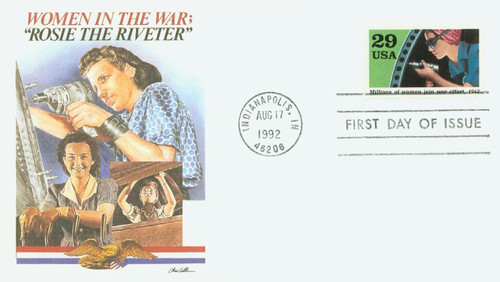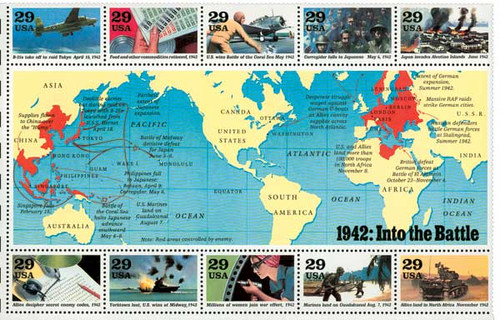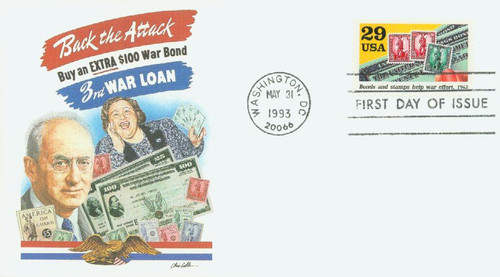
# 2697h - 1992 29c World War II: Millions of Women Join War Effort
US #2697h
1992 Millions of Women Join War Effort, 1942
- Part of the second Souvenir Sheet issued to commemorate 50th anniversary of World War II
- Sheet contains 10 stamps and a world map.
Stamp Category: Commemorative
Set: 1942: Into the Battle, World War II
Value: 29¢ First Class Mail Rate
First Day of Issue: August 17, 1992
First Day City: Indianapolis, Indiana
Quantity Issued: 12,000,000 stamps
Printed by: Bureau of Engraving and Printing
Printing Method: offset/ intaglio
Format: Sheetlets of 10, arranged in two strips of 5 with a world map between. Offset printing plates of 8 sheetlets (2 across, 4 down). Intaglio printing sleeves of 16 sheetlets (2 across, 8 down)
Perforations: 11
Why the stamp was issued: This stamp is part of a sheetlet issued to commemorate the 50th anniversary of World War II. It was the second in a series of five that were issued over the course of five years.
About the stamp design: There were many topics the USPS wanted to cover when commemorating World War II, but those planning the series didn’t want to issue a large number of stamps. It was decided a sheetlet format would best highlight the main events of the war. In order for all the sheetlets to have a uniform design, the same artist, William Bond, and art director, Howard Paine, were assigned to the entire project.
Bond produced a painting showing a female factory worker with goggles and her hair in a scarf. She is working on a piece of military equipment, though it isn’t clear what that is.
Special design details: Though the sheet is very similar to the 1991 issue, there are some small changes. In this sheet, the year 1942 was added to each individual stamp. The previous sheet only had the year on the map, so if the stamps were separated it would have been difficult to identify the year the stamp was commemorating. In addition, an explanation was added to the map which read, “Red areas controlled by enemy.”
First Day City: The First Day of Issue ceremony took place at the national convention of the Veterans of Foreign Wars of the United States, which took place in Indianapolis, Indiana.
About the World War II Series: As the 50th anniversary of World War II was approaching the US Postal Service wanted a series that would recognize the key events of the war and the important contributions America made to the Allied victory. Rather than issue a large number of stamps, the USPS decided to create five sheetlets, each commemorating one year of America’s involvement in the war. Each sheetlet had 10 different stamps arraigned in two horizontal strips of 5. In the center was a world map with Allied and neutral nations in yellow and Axis-controlled areas in red. Notes on the map highlighted key developments that occurred that year. The stamps each featured important events that took place during the year, as well.
History the stamp represents:
As young men went off to war and America’s war machine geared up, women soon found jobs that had been forbidden for them to fill in the past. Between 1940 and 1945, five million women entered the workforce. Many worked in defense plants and factories, building ships and aircraft. In order to recruit enough females to fill the open positions, the government created the Rosie the Riveter campaign.
While many women worked in factories and offices, about 350,000 joined the military. They fulfilled the duties of nurses, truck drivers, pilots, and many other positions.
When the war ended, most women were replaced in their jobs by men returning from war. During their time in the workforce, women had proven they could perform difficult jobs well. They laid the foundation for generations of women who also pioneered in fields formerly reserved for men.
US #2697h
1992 Millions of Women Join War Effort, 1942
- Part of the second Souvenir Sheet issued to commemorate 50th anniversary of World War II
- Sheet contains 10 stamps and a world map.
Stamp Category: Commemorative
Set: 1942: Into the Battle, World War II
Value: 29¢ First Class Mail Rate
First Day of Issue: August 17, 1992
First Day City: Indianapolis, Indiana
Quantity Issued: 12,000,000 stamps
Printed by: Bureau of Engraving and Printing
Printing Method: offset/ intaglio
Format: Sheetlets of 10, arranged in two strips of 5 with a world map between. Offset printing plates of 8 sheetlets (2 across, 4 down). Intaglio printing sleeves of 16 sheetlets (2 across, 8 down)
Perforations: 11
Why the stamp was issued: This stamp is part of a sheetlet issued to commemorate the 50th anniversary of World War II. It was the second in a series of five that were issued over the course of five years.
About the stamp design: There were many topics the USPS wanted to cover when commemorating World War II, but those planning the series didn’t want to issue a large number of stamps. It was decided a sheetlet format would best highlight the main events of the war. In order for all the sheetlets to have a uniform design, the same artist, William Bond, and art director, Howard Paine, were assigned to the entire project.
Bond produced a painting showing a female factory worker with goggles and her hair in a scarf. She is working on a piece of military equipment, though it isn’t clear what that is.
Special design details: Though the sheet is very similar to the 1991 issue, there are some small changes. In this sheet, the year 1942 was added to each individual stamp. The previous sheet only had the year on the map, so if the stamps were separated it would have been difficult to identify the year the stamp was commemorating. In addition, an explanation was added to the map which read, “Red areas controlled by enemy.”
First Day City: The First Day of Issue ceremony took place at the national convention of the Veterans of Foreign Wars of the United States, which took place in Indianapolis, Indiana.
About the World War II Series: As the 50th anniversary of World War II was approaching the US Postal Service wanted a series that would recognize the key events of the war and the important contributions America made to the Allied victory. Rather than issue a large number of stamps, the USPS decided to create five sheetlets, each commemorating one year of America’s involvement in the war. Each sheetlet had 10 different stamps arraigned in two horizontal strips of 5. In the center was a world map with Allied and neutral nations in yellow and Axis-controlled areas in red. Notes on the map highlighted key developments that occurred that year. The stamps each featured important events that took place during the year, as well.
History the stamp represents:
As young men went off to war and America’s war machine geared up, women soon found jobs that had been forbidden for them to fill in the past. Between 1940 and 1945, five million women entered the workforce. Many worked in defense plants and factories, building ships and aircraft. In order to recruit enough females to fill the open positions, the government created the Rosie the Riveter campaign.
While many women worked in factories and offices, about 350,000 joined the military. They fulfilled the duties of nurses, truck drivers, pilots, and many other positions.
When the war ended, most women were replaced in their jobs by men returning from war. During their time in the workforce, women had proven they could perform difficult jobs well. They laid the foundation for generations of women who also pioneered in fields formerly reserved for men.










